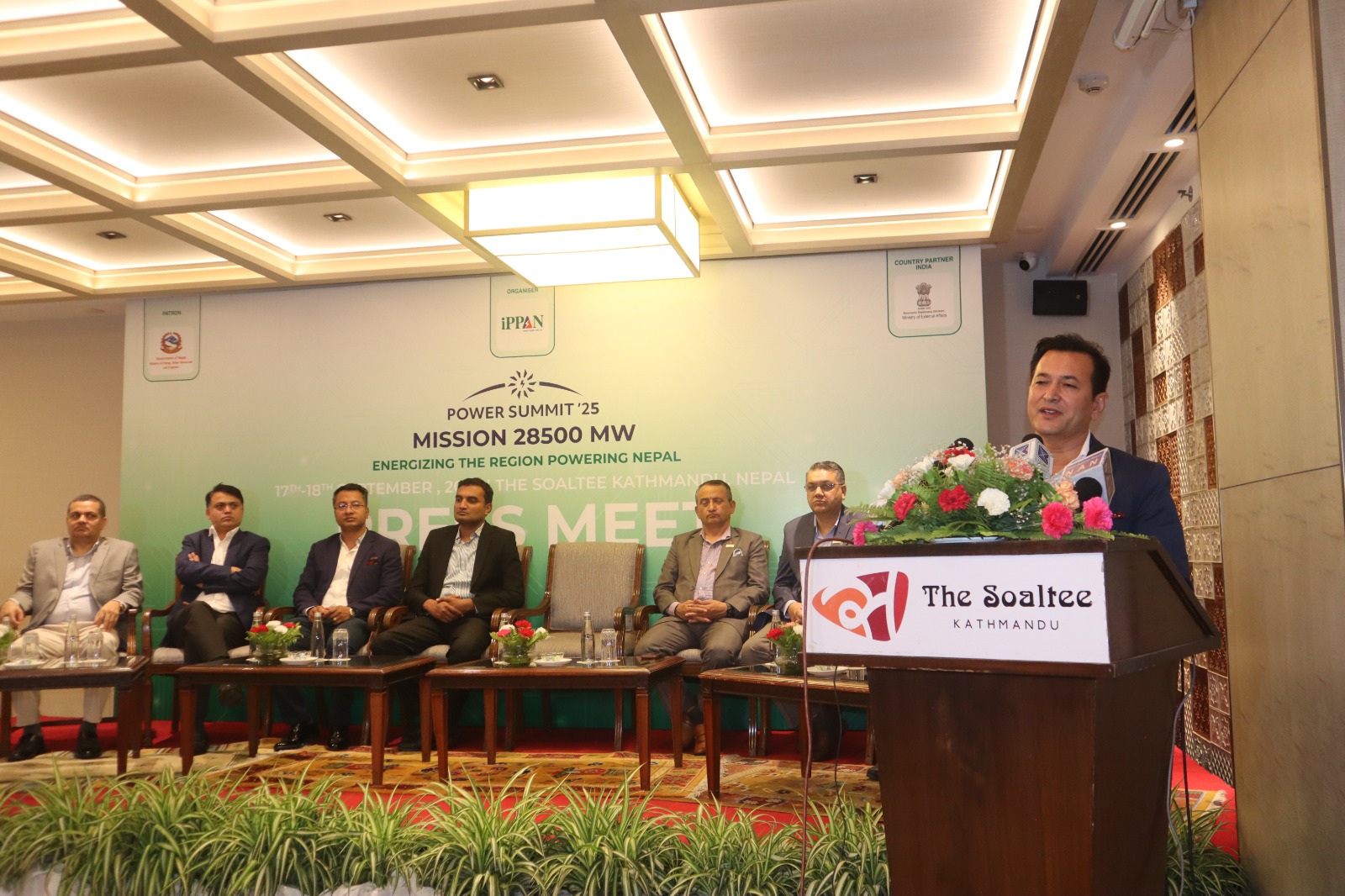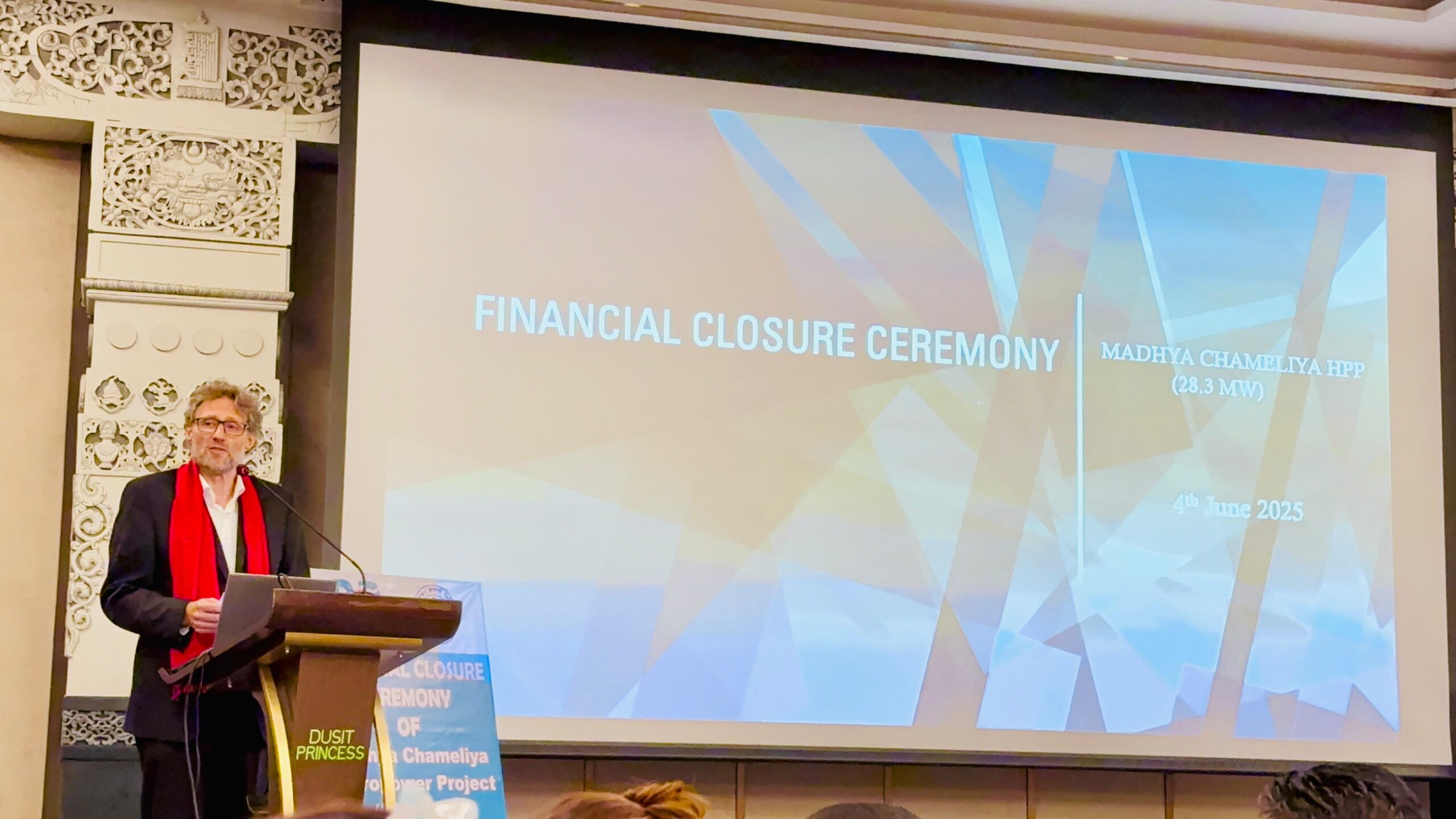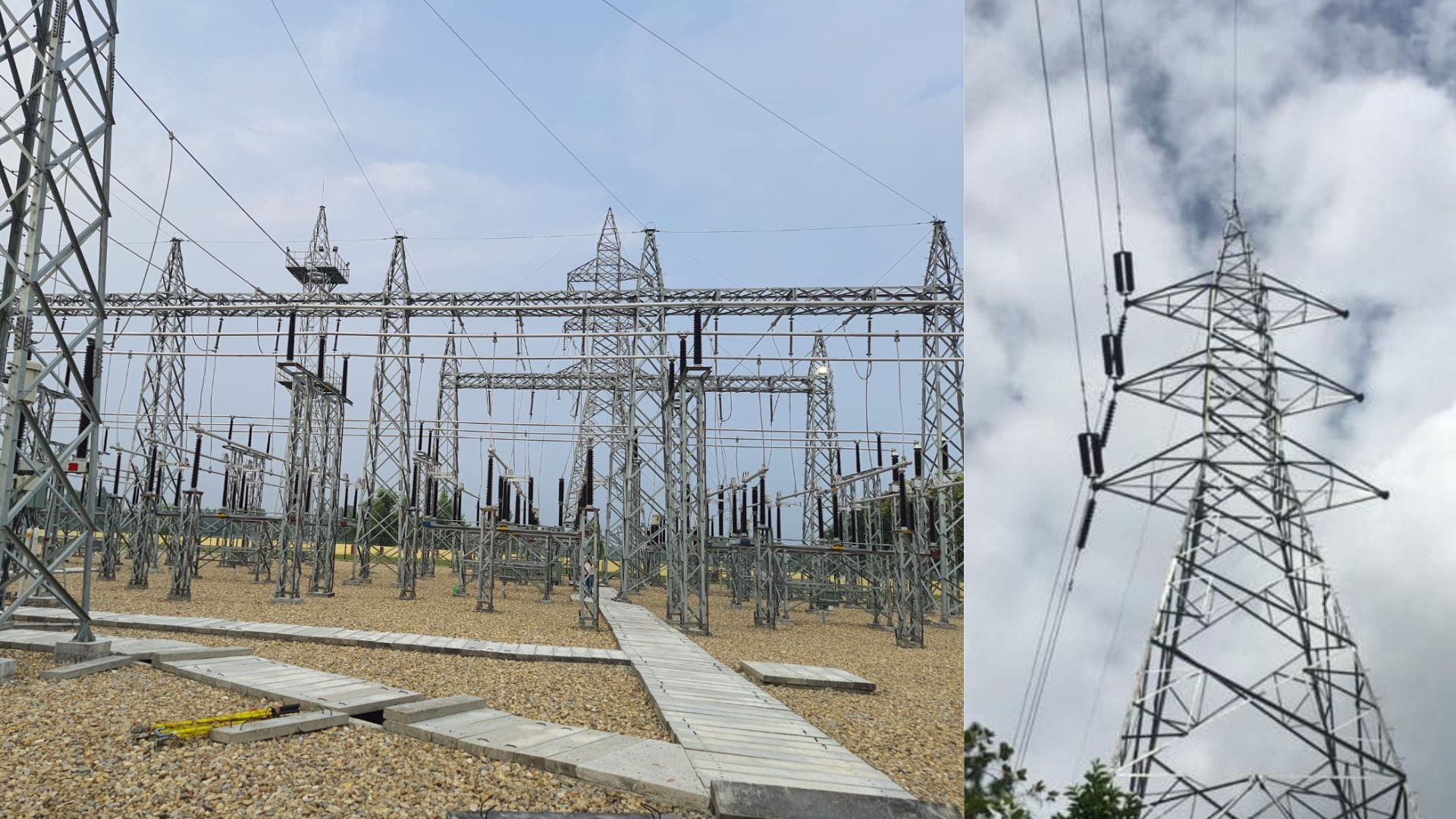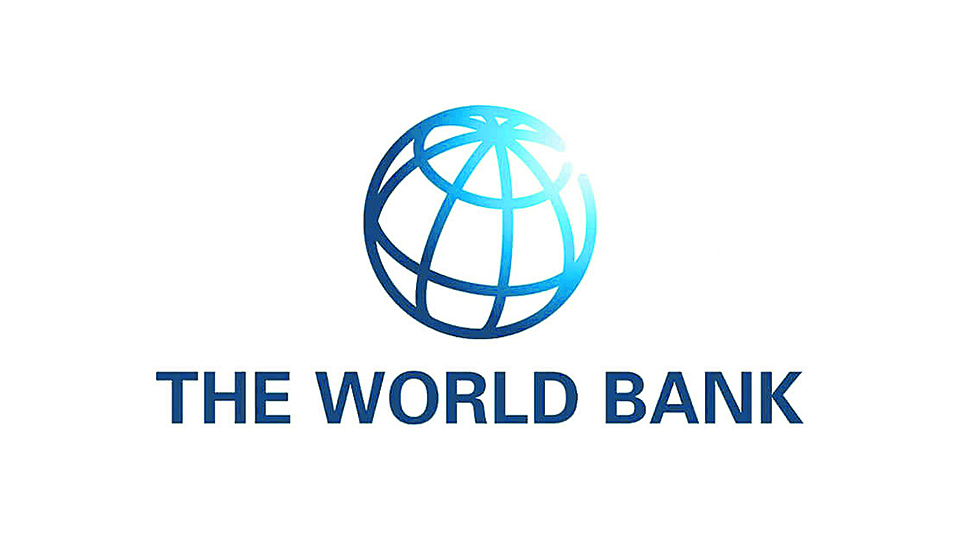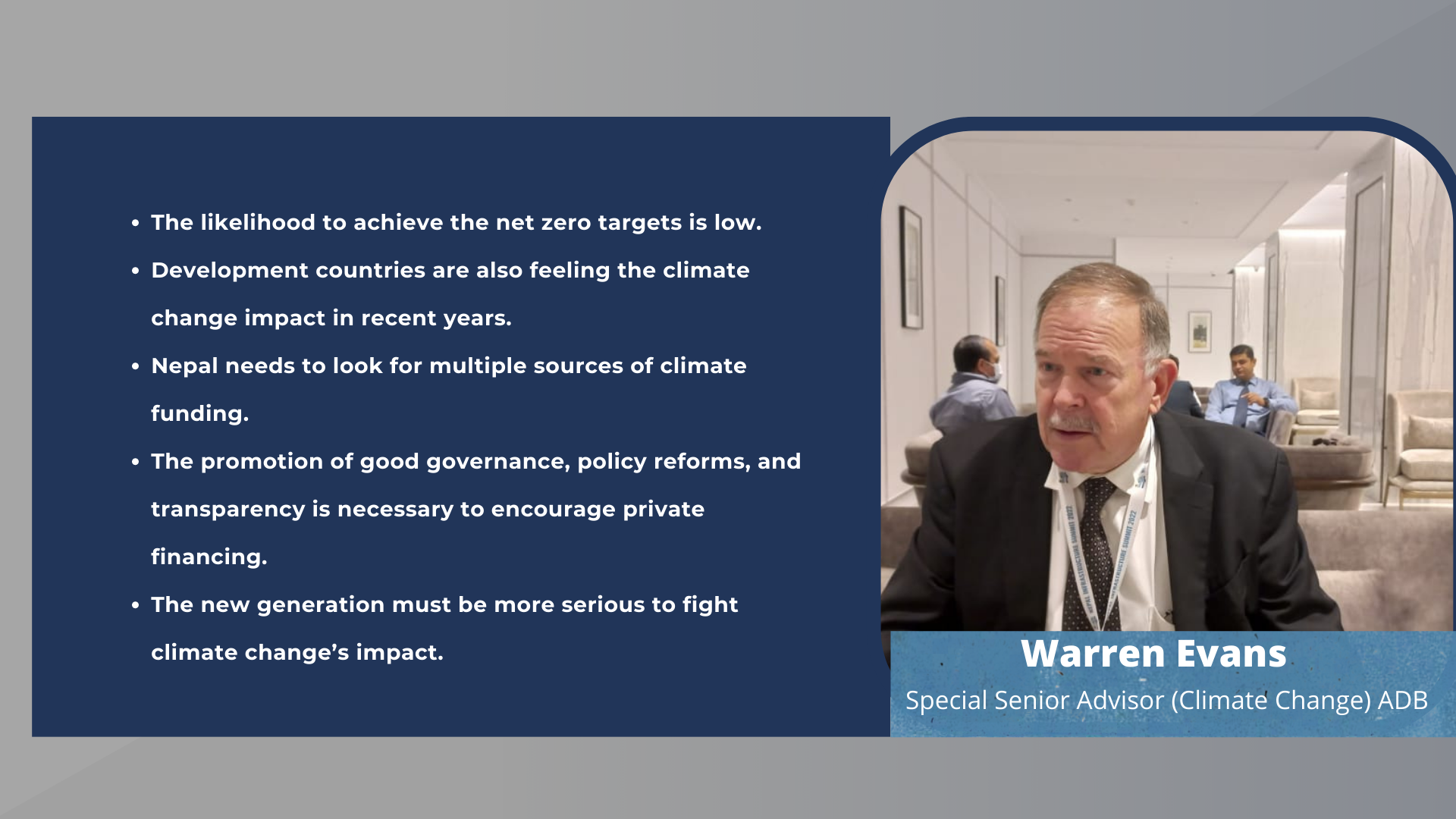
Warren Evans is the Special Senior Advisor (Climate Change), at the Office of the President of the Asian Development Bank (ADB). Evans gained more than 40 years of experience in sustainable development and climate change working with various financial institutions, private organizations, and other high-profile agencies. He holds a Ph.D. in cleaner production and climate change policy from Erasmus University Rotterdam in the Netherlands. He has also an academic background in environmental health engineering and ecology. Talking to Bhim Gautam/editor of nepalinfrastructure.com, he emphasized the need to act urgently to mitigate climate change effects and highlighted the vulnerability of many countries like Nepal, which are not contributing to climate change but bearing the burnt most, of the worsening effects of the climate change.
You have been observing climate change and its impact across the world. Could you tell us how sensitive is the climate change issue for the globe?
Firstly, the prediction of climate change impacts that have been made over the last 20 years is all coming true but at a faster pace than was anticipated. The kinds of impacts we are seeing today are flooding in Pakistan, drought, a forest fire in the US and Europe, and heat waves all over the world. Those are all of them that were predicted to happen but not in the intensity and frequency that they already happen. So, what those means is that we already have about 1.2 degrees centigrade pre-industrial temperature, and the objective of the Paris Agreements i.e. the international agreements is to limit this to 1.5 degrees. The likelihood of achieving this target is very low because we are not on the track to achieving that. Even when the commitments from different countries are not going to limit global warming to 1.5 degrees.
These all are risks that directly hamper the health, and livelihood of particular rural poor communities, which are vulnerable. The focus is needed to give in the countries like Nepal. We need to increase our research on those impacts and necessary preparation.
What is your assessment of Nepal regarding climate change impact?
Countries like Nepal, are not major emitters and minor sources of greenhouse gases emission globally. However, they are at high risk of climate change impact. Whether it is going to be drought, heat in the Terai region or lack of water in western Nepal, where we are building hydropower projects, or the kinds of issues, we had seen in the last year with the landslide that damaged the Melamchi water supply system.
These all are risks that directly hamper the health, and livelihood of particular rural poor communities, which are vulnerable. The focus is needed to give in the countries like Nepal. We need to increase our research on those impacts and necessary preparation. That can be done in a number of different ways. Nepal has an opportunity to reduce its greenhouse gas mission and it’s important to recognize where the greenhouse gases emitted have an effect on global climate change.
If so, what particular challenge you have been observing in Nepal, and what are the ways to deal with them?
I have been visiting Nepal since 1978 and getting the opportunity to observe changes seen in the mountains again. The major challenge for Nepal is climate risks and building resilience to those risks. The global community is watching the potential reason for Glacier Lake Outburst Flood (GLOF), particularly in Nepal. We have been monitoring it for those for a long time. The pressure of rainfall in high mountains and rapid melting of glaciers and resulting floods as well as landslide are posing increasing challenges. But we are not prepared to tackle them.
But lately, the developed countries now are feeling the impacts of climate change in the form of heat waves, fires, and increased flooding which happened across Europe, and the USA. So hopefully, such climate activities will make them more sympathetic to a much more high-level vulnerability.
In a country like Nepal what can be done is to focus on the risks posed by the climate change phenomenon. Such risks emerged not because of Nepal but because of other countries which cause Green House Gas (GHG) emissions. But developing countries are doing a better job collectively putting pressure on richer countries responsible for increasing emissions, to support climate adaptation and climate resilience capacity building. However, there is not enough progress. Frankly speaking, those discussions are not coming together yet. But lately, the developed countries now are feeling the impacts of climate change in the form of heat waves, fires, and increased flooding which happened across Europe, and the USA. So hopefully, such climate activities will make them more sympathetic to a much more high-level vulnerability. Poor communities don’t have enough money to go and live somewhere else where they feel safer. So they suffer more seriously than richer countries. I hope that recognition will result in a more compassionate approach to supporting more vulnerable countries. However, it’s just my personal view I don’t know about the fact.
The most vulnerable country Nepal is facing a fund gap to face climate change impact. How can Nepal get key international funding?
I think the sources including concessional finance for adaptation are quite probably never going to be sufficient actually to meet the needs of every vulnerable country. Nepal needs to tap the green climate fund, climate investment fund, and bilateral donors as much as possible. Asian Development Bank can be another source. At the same time, we think that it’s going to be increasingly important to come up with a more innovative financial mechanism. Nepal can get a grant from one of that climate funds for climate-resilient water supply, and drainage systems in some of the vulnerable towns in Nepal. A climate bond with a guarantee from ADB or other agencies can be introduced to mobilize a larger volume of funding to be able to implement those climate-resilient projects. Hence, instead of relying on traditional allowances and grants, it would be prudent to actually mobilize resources in different ways. There’s a lot being done right now in terms of targeted bonds to try and mobilize finance. It’s going to be an experiment that will be something relatively new. It’s going to be essential to find new bonds for finance.
Hence, instead of relying on traditional allowances and grants, it would be prudent to actually mobilize resources in different ways. There’s a lot being done right now in terms of targeted bonds to try and mobilize finance.
How can we attract the private sector to green financing or green infrastructure at a time when climate change impact is deepening inflicting many countries in the world?
There is a need for good governance and transparency arrangements in almost every country where we work. Policy reform and regulatory reform open the door for the private sector to be more involved in financing climate actions and institutional capacity at the government level. Such requirements are something that the government can’t borrow but undertake. If such initiatives are private sector will be attracted to green infrastructure financing.
How can it be possible to complete such initiatives as you prescribe?
I don’t have enough knowledge about Nepal to make that judgment. However, I clearly have felt the increased climate risk that Nepal may faces with the high level of vulnerability, particularly in rural communities by small farmers, and so on. Nepal needs to deal with these challenges with very quick responses because those impacts are not going to wait, those impacts will be completely out of control. It’s a matter of time, time is short. So, it’s a question of whether the government can step up and addresses it or not. It is not only for Nepal but also for richer or developed countries as well.
What role can ADB play to support Nepal’s climate change initiatives?
There are two aspects. One is, ADB is very keen to help Nepal to understand the risk and opportunities of climate change. They do analytical research to understand how to decrease the different sectors of development so that there would be more climate resilient. We are more than happy. We are already willing to provide that kind of support along with a number of other donors including bilateral development partners. So that’s a new area of work. Most of the support that ADB provides to Nepal is already in transport, energy, water supply, community development, and others. We have to change how we do that we have to change the mindset on planning those projects. So, from the very beginning plan to understand the climate risk and built those projects so that they are climate resilient and equally important to help the communities. We can plan and implement projects that are intended to support and help those communities for more climate resilience.
I hope that political leadership globally will make the commitments and stick with them. But it’s hard for me to be very optimistic about what will happen. I am sorry about that.
Given the worsening climate impact, what would be the condition of the world after 30 years?
I wish I could say I was optimistic. I know there is not too late to reduce the net zero target. I personally doubt whether we will be able to limit the temperature rise to 1.5 degrees. That difference from 1.5 to 2.0 has a significant risk to countries like Nepal or island states. I know that it can be done but history does not make me optimistic. The climate negotiation that I have been following for many years and involved in some have not resulted in sincere political commitment. I hope that political leadership globally will make the commitments and stick with them. But it’s hard for me to be very optimistic about what will happen. I am sorry about that.
Do you have any climate messages for all people in the world?
I don’t know about all the people in the world, but I do have a message for younger generations here across all the countries particularly highly vulnerable developing countries like Nepal. We are leaving you the world with a very difficult situation, that’s unfortunate. But it’s now up to you to figure out how to change, consumption, change production patterns and become sustainable and resilient to climate impacts that are going to hit. I hope young generations will reduce the risk they are going to have.


